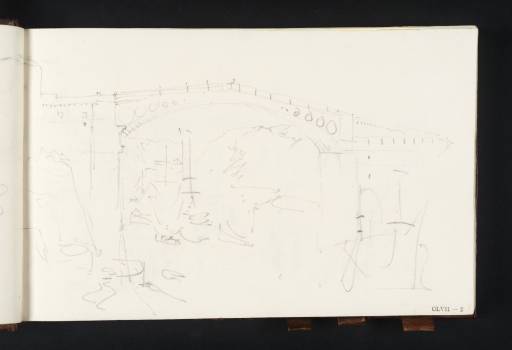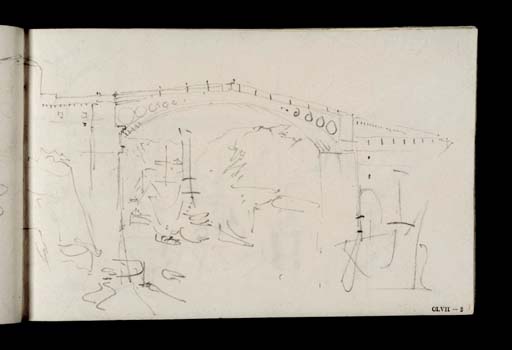Joseph Mallord William Turner Wearmouth Bridge, Sunderland, from Downstream 1817
Image 1 of 2
Joseph Mallord William Turner,
Wearmouth Bridge, Sunderland, from Downstream
1817
Joseph Mallord William Turner 1775–1851
Folio 3 Recto:
Wearmouth Bridge, Sunderland, from Downstream 1817
D12321
Turner Bequest CLVII 3
Turner Bequest CLVII 3
Pencil on white wove paper, 116 x 185 mm
Part watermark ‘J Wh | 18’
Inscribed by John Ruskin in red ink ‘3’ bottom right (now faint)
Stamped in black ‘CLVII – 3’ bottom right
Part watermark ‘J Wh | 18’
Inscribed by John Ruskin in red ink ‘3’ bottom right (now faint)
Stamped in black ‘CLVII – 3’ bottom right
Accepted by the nation as part of the Turner Bequest 1856
References
1909
A.J. Finberg, A Complete Inventory of the Drawings of the Turner Bequest, London 1909, vol.I, p.449, CLVII 3, as ‘Bridge at Newcastle-on-Tyne’.
1974
Gerald Wilkinson, The Sketches of Turner, R.A. 1802–20: Genius of the Romantic, London 1974, reproduced p.170, as ‘Newcastle-on-Tyne’.
This is Turner’s most detailed drawing of Sunderland’s cast-iron bridge, made from downstream on the south bank of the Wear and looking north-east through its single arch. Inspired by the 1779 Iron Bridge at Coalbrookdale, Wearmouth Bridge opened in 1796, when it was the largest single span of its type at about 75 metres (250 feet), with a high arch to allow sailing ships to pass underneath. It was partially rebuilt by Robert Stephenson in the 1850s, and replaced on the same site by the current bridge, an arch with a suspended deck, in 1929.1 By then a railway bridge of a similar type had been built in parallel, just upstream.
The stone abutments had several storeys built into them; one full row of windows is marked in Turner’s drawing. The arch allowing access along the bank through the northern range is also lightly indicated beyond the sails on the right. There is a brief continuation of the toll house high on the southern approach to the bridge on folio 2 verso opposite (D12320). A wood engraving by Robert Johnson after Abraham Hunter shows the bridge from the same viewpoint, and a watercolour of 1849 by James Wood shows this downstream side in its wider context (both Tyne & Wear Museums).2
There are sketches of the bridge from upstream on folios 4 recto and 5 recto (D12323, D12325), and views of Sunderland Harbour on folios 1 recto and 2 recto (D12318, D12319). Finberg mistakenly identified the bridge’s setting as Newcastle;3 the correct identification has been made independently of the present author by Juliet Horsley of Tyne & Wear Museums.4
Matthew Imms
February 2010
See R.W. Rennison, Northern England, Civil Engineering Heritage, 2nd ed. London 1996, pp.63–4, and ‘Local Studies Factsheet Number 7: The Wearmouth Bridge’, Sunderland City Council, accessed 10 August 2009, http://www.sunderland.gov.uk/libraries/Leaflets/Wearmouth%20Bridge.pdf .
For images and captions, see Imagine: Tyne & Wear Collections online, accessed 11 August 2009, http://www.imagine.org.uk/details/index.php?id=TWCMS:E3482 and http://www.imagine.org.uk/details/index.php?id=TWCMS:C12817 respectively.
How to cite
Matthew Imms, ‘Wearmouth Bridge, Sunderland, from Downstream 1817 by Joseph Mallord William Turner’, catalogue entry, February 2010, in David Blayney Brown (ed.), J.M.W. Turner: Sketchbooks, Drawings and Watercolours, Tate Research Publication, December 2012, https://www


